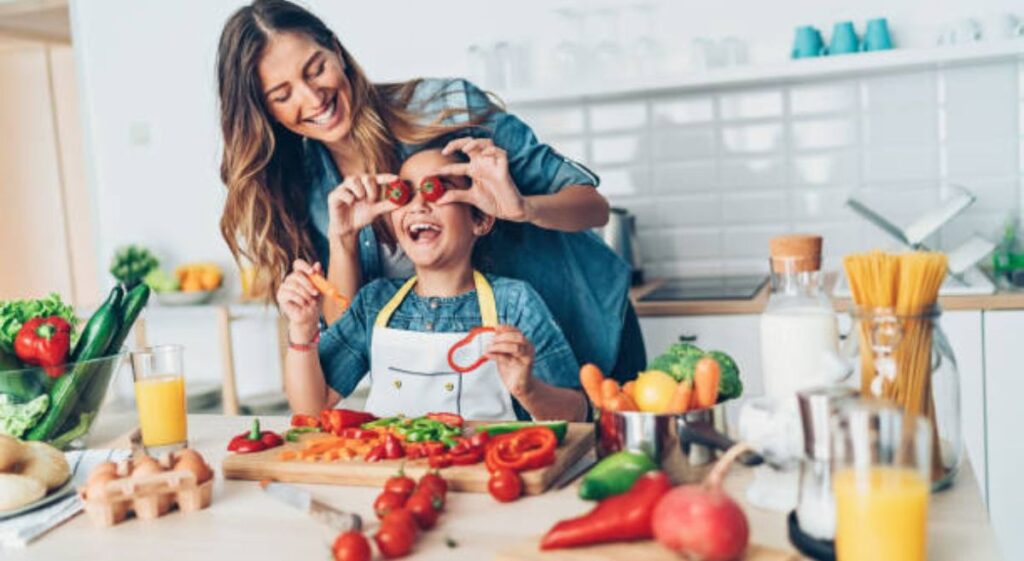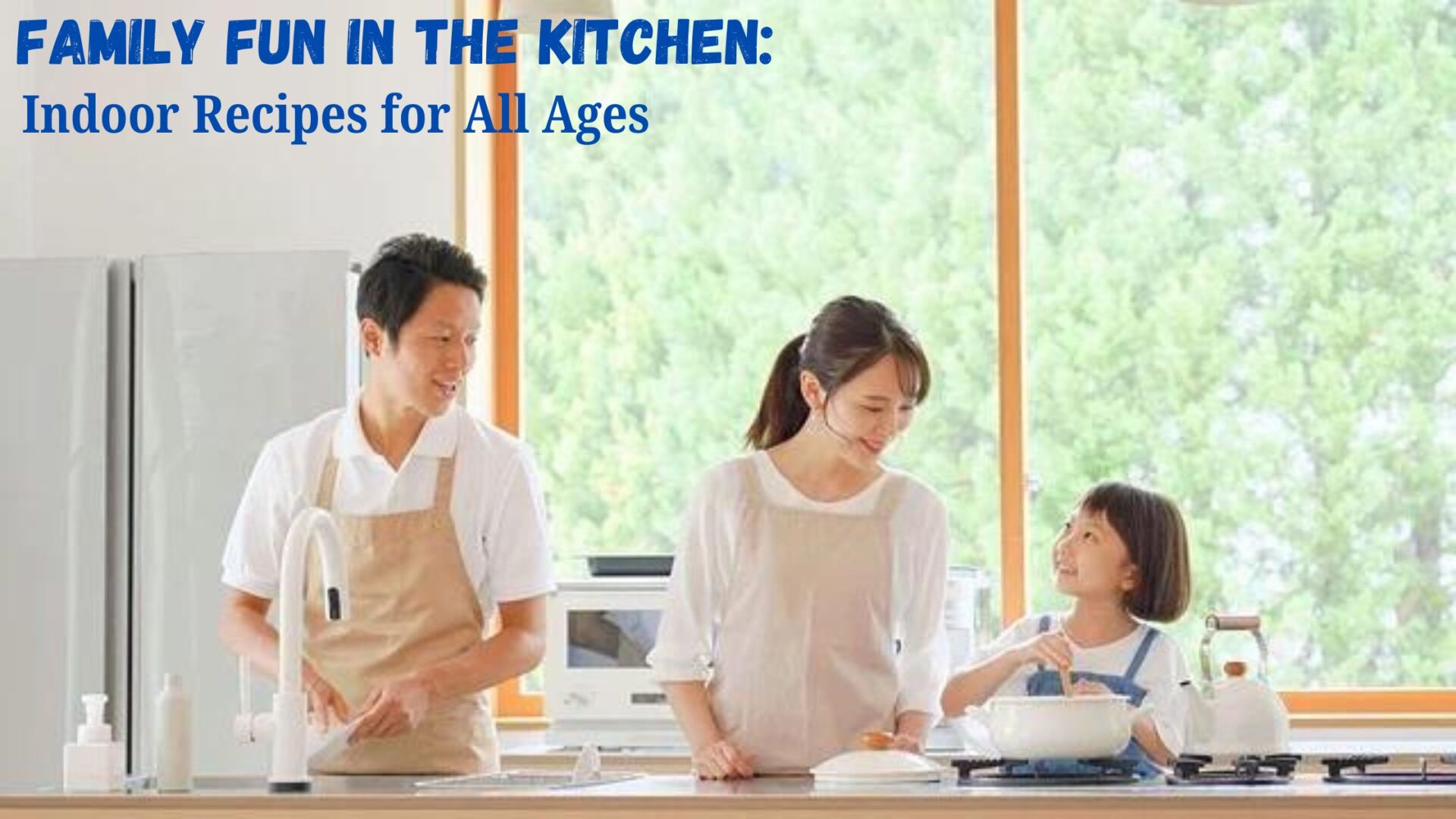Introduction:-
Family Fun in the Kitchen: Indoor Recipes for All Ages

Engaging in family cooking not only strengthens bonds but also imparts essential life skills to children. These indoor recipes cater to all ages, whether you seek a fun weekend activity or aim to involve everyone in meal preparation. Let’s embark on a culinary journey with some delectable and simple recipes, transforming your kitchen into a place of joy and laughter.
Family Fun in the Kitchen
1. Mini Pizzas
Ingredients:
- English muffins or pre-made pizza dough
- Tomato sauce
- Shredded mozzarella cheese
- Assorted toppings (pepperoni, bell peppers, mushrooms, olives, etc.)
Instructions:
- Preheat your oven to 375°F (190°C).
- Spread tomato sauce on each English muffin half or pizza dough.
- Sprinkle a generous amount of shredded mozzarella cheese on top.
- Add your favorite toppings.
- Place the mini pizzas on a baking sheet and bake for 10-12 minutes or until the cheese is bubbly and golden.
- Let them cool slightly before serving.
Why It’s Great for Families: Mini pizzas are customizable, allowing each family member to choose their favorite toppings. It’s a simple recipe that even the youngest chefs can help with.
2. Rainbow Veggie Wraps
Ingredients:
- Whole wheat tortillas
- Hummus or cream cheese
- Assorted veggies (carrots, bell peppers, cucumbers, spinach, etc.)
- Grated cheese (optional)
Instructions:
- Lay out a tortilla on a flat surface.
- Spread a layer of hummus or cream cheese over the tortilla.
- Arrange the assorted veggies in a rainbow pattern on top of the spread.
- Sprinkle with grated cheese if desired.
- Roll up the tortilla tightly and slice it into pinwheels or halves.
Why It’s Great for Families: This recipe encourages kids to eat more veggies and lets them be creative with their wrap designs. It’s also a quick and healthy lunch or snack option.
3. Pancake Art
Ingredients:
- Pancake batter (homemade or store-bought)
- Food coloring (optional)
- Toppings (fresh fruit, chocolate chips, syrup, etc.)
Instructions:
- Prepare your pancake batter according to the recipe or package instructions.
- Divide the batter into small bowls and add a few drops of food coloring to each, if using.
- Heat a non-stick skillet over medium heat.
- Pour the batter into squeeze bottles or use spoons to create fun shapes and designs on the skillet.
- Cook until bubbles form on the surface, then flip and cook until golden brown.
- Serve with your favorite toppings.
Why It’s Great for Families: Pancake art is a fun and imaginative way to start the day. Kids can design their own pancakes, making breakfast a creative and interactive experience.
4. DIY Taco Bar
Ingredients:
- Soft or hard taco shells
- Ground beef, chicken, or turkey
- Taco seasoning
- Assorted toppings (lettuce, tomatoes, cheese, sour cream, guacamole, salsa, etc.)
Instructions:
- Cook the ground meat in a skillet over medium heat until browned. Add taco seasoning and water according to the package instructions.
- Set up a taco bar with all the toppings in separate bowls.
- Let each family member build their own tacos with their preferred ingredients.
Why It’s Great for Families: A DIY taco bar allows everyone to customize their meal, catering to different tastes and dietary preferences. It’s also a great way to involve kids in meal preparation.
5. Fruit Kabobs with Yogurt Dip
Ingredients:
- Assorted fresh fruit (strawberries, grapes, pineapple, melon, etc.)
- Wooden skewers
- Yogurt (Greek or regular)
- Honey or maple syrup
Instructions:
- Wash and cut the fruit into bite-sized pieces.
- Thread the fruit onto the wooden skewers, alternating types of fruit for a colorful display.
- In a small bowl, mix yogurt with a drizzle of honey or maple syrup.
- Serve the fruit kabobs with the yogurt dip on the side.
Why It’s Great for Families: Fruit kabobs are a healthy and refreshing treat that kids will love making and eating. The yogurt dip adds an element of fun and flavor.
What are the benefits of cooking with your family?
Cooking with your family offers numerous benefits that extend beyond the kitchen. Here are some key advantages:

1. Quality Time Together
- Bonding: Cooking provides a structured yet relaxed environment where family members can spend quality time together.
- Conversation: It creates opportunities for meaningful conversations and sharing daily experiences.
2. Educational Opportunities
- Skill Development: Children and adults alike can learn valuable cooking skills and techniques.
- Nutrition Education: It’s an excellent way to teach children about healthy eating habits and the nutritional value of different foods.
3. Healthy Eating Habits
- Home-cooked Meals: Families are more likely to eat nutritious meals when they cook at home.
- Balanced Diet: Cooking together allows control over ingredients, promoting a balanced diet.
4. Cultural Heritage
- Traditions: Cooking family recipes helps pass down cultural traditions and heritage.
- Culinary Skills: It preserves and teaches culinary skills unique to a family’s background.
5. Life Skills
- Responsibility: Cooking involves planning, preparation, and cleanup, teaching responsibility and time management.
- Problem Solving: It encourages problem-solving and adaptability, especially when recipes don’t go as planned.
6. Economic Benefits
- Cost-effective: Cooking at home is generally more economical than eating out.
- Budgeting: It provides a practical way to teach children about budgeting and the cost of groceries.
7. Emotional and Psychological Benefits
- Stress Relief: Cooking can be a therapeutic and stress-relieving activity.
- Sense of Accomplishment: Completing a meal provides a sense of achievement and boosts self-esteem.
8. Encourages Teamwork
- Collaboration: Cooking together fosters teamwork and cooperation.
- Role Assignment: Family members can take on different roles, enhancing collaborative skills.
9. Creativity and Experimentation
- Innovative Cooking: It encourages creativity in the kitchen through experimenting with recipes and ingredients.
- Expression: Cooking becomes a medium for expressing individuality and culinary flair.
10. Foundation for Lifelong Habits
- Early Exposure: Children exposed to cooking at a young age are more likely to develop a lifelong interest in cooking and healthy eating.
- Independence: It prepares children to be self-sufficient and capable of preparing their own meals in the future.
Cooking with your family is a multifaceted activity that promotes togetherness, education, and healthy living. It not only strengthens family bonds but also instills valuable life skills and habits that last a lifetime.
How can I get my kids interested in cooking?
Getting kids interested in cooking can be a fun and rewarding experience. Here are some strategies to engage them in the kitchen:

1. Start with Simple Recipes
- Begin Easy: Choose simple, fun recipes that match their skill level, such as sandwiches, salads, or no-bake cookies.
- Gradual Progression: Gradually introduce more complex recipes as they gain confidence and skills.
2. Make It Fun
- Playful Approach: Turn cooking into a game by having themed cooking days or creating fun shapes with food.
- Incorporate Creativity: Encourage them to decorate cookies or pizzas with their favorite toppings.
3. Involve Them in Planning
- Recipe Selection: Let them help choose recipes and plan meals for the week.
- Shopping Together: Take them grocery shopping and let them pick out ingredients.
4. Teach Safety and Hygiene
- Safety First: Teach them about kitchen safety, such as using knives properly and handling hot surfaces.
- Hygiene: Emphasize the importance of washing hands and keeping the cooking area clean.
5. Assign Age-appropriate Tasks
- Younger Kids: Give them simple tasks like stirring, pouring, or washing vegetables.
- Older Kids: Allow them to take on more challenging tasks, such as measuring ingredients or using appliances with supervision.
6. Encourage Exploration
- New Ingredients: Introduce new ingredients and let them taste and learn about different foods.
- Culinary Techniques: Teach them various cooking techniques and let them experiment.
7. Create a Kid-friendly Cooking Space
- Accessible Tools: Ensure they have access to child-friendly cooking tools and utensils.
- Safe Environment: Create a safe and comfortable cooking space for them to work in.
8. Praise and Encourage
- Positive Reinforcement: Praise their efforts and accomplishments, no matter how small.
- Encouragement: Encourage them to keep trying and learning, even if mistakes happen.
9. Make It a Family Activity
- Cook Together: Make cooking a family activity where everyone participates.
- Special Time: Use this time to bond and create positive memories together.
10. Incorporate Learning
- Math and Science: Use cooking to teach math (measuring ingredients) and science (baking reactions).
- Cultural Education: Explore different cuisines to teach them about various cultures and traditions.
By making cooking a fun, engaging, and educational experience, you can spark your kids’ interest in the kitchen. Involving them in the process, providing age-appropriate tasks, and creating a positive and safe environment will help them develop a lifelong appreciation for cooking and healthy eating.
Conclusion
Engaging in family cooking sessions offers a delightful opportunity to forge lasting memories and impart valuable culinary skills to all members. These indoor recipes are specially tailored to cater to all age groups, making them ideal for inclusive family cooking activities. Gather your ingredients, don your aprons, and embark on a delightful culinary journey with your loved ones, creating delicious meals while strengthening family bonds.
References
- Smith, J. (2023). Family Cooking: Fun Recipes for Kids and Parents. Retrieved from Food Network.
- Johnson, A. (2022). 10 Simple Recipes for Family Cooking. Retrieved from AllRecipes.
- Martinez, R. (2021). Healthy Family Meals: Cooking with Kids. Retrieved from Eating Well.
- Brown, L. (2020). The Joy of Cooking Together: Family Recipes. Retrieved from Epicurious.
- Davis, M. (2019). Creative Cooking: Fun Food for Families. Retrieved from Delish.








